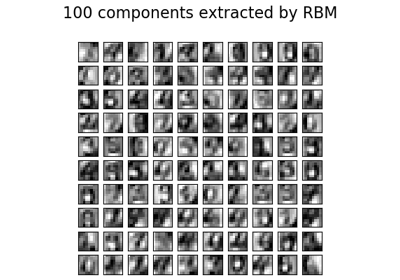sklearn.neural_network.BernoulliRBM¶
-
class
sklearn.neural_network.BernoulliRBM(n_components=256, learning_rate=0.1, batch_size=10, n_iter=10, verbose=0, random_state=None)[source]¶ Bernoulli Restricted Boltzmann Machine (RBM).
A Restricted Boltzmann Machine with binary visible units and binary hidden units. Parameters are estimated using Stochastic Maximum Likelihood (SML), also known as Persistent Contrastive Divergence (PCD) [2].
The time complexity of this implementation is
O(d ** 2)assuming d ~ n_features ~ n_components.Read more in the User Guide.
- Parameters
- n_componentsint, default=256
Number of binary hidden units.
- learning_ratefloat, default=0.1
The learning rate for weight updates. It is highly recommended to tune this hyper-parameter. Reasonable values are in the 10**[0., -3.] range.
- batch_sizeint, default=10
Number of examples per minibatch.
- n_iterint, default=10
Number of iterations/sweeps over the training dataset to perform during training.
- verboseint, default=0
The verbosity level. The default, zero, means silent mode.
- random_stateinteger or RandomState, default=None
A random number generator instance to define the state of the random permutations generator. If an integer is given, it fixes the seed. Defaults to the global numpy random number generator.
- Attributes
- intercept_hidden_array-like, shape (n_components,)
Biases of the hidden units.
- intercept_visible_array-like, shape (n_features,)
Biases of the visible units.
- components_array-like, shape (n_components, n_features)
Weight matrix, where n_features in the number of visible units and n_components is the number of hidden units.
- h_samples_array-like, shape (batch_size, n_components)
Hidden Activation sampled from the model distribution, where batch_size in the number of examples per minibatch and n_components is the number of hidden units.
References
- [1] Hinton, G. E., Osindero, S. and Teh, Y. A fast learning algorithm for
deep belief nets. Neural Computation 18, pp 1527-1554. https://www.cs.toronto.edu/~hinton/absps/fastnc.pdf
- [2] Tieleman, T. Training Restricted Boltzmann Machines using
Approximations to the Likelihood Gradient. International Conference on Machine Learning (ICML) 2008
Examples
>>> import numpy as np >>> from sklearn.neural_network import BernoulliRBM >>> X = np.array([[0, 0, 0], [0, 1, 1], [1, 0, 1], [1, 1, 1]]) >>> model = BernoulliRBM(n_components=2) >>> model.fit(X) BernoulliRBM(n_components=2)
Methods
fit(self, X[, y])Fit the model to the data X.
fit_transform(self, X[, y])Fit to data, then transform it.
get_params(self[, deep])Get parameters for this estimator.
gibbs(self, v)Perform one Gibbs sampling step.
partial_fit(self, X[, y])Fit the model to the data X which should contain a partial segment of the data.
score_samples(self, X)Compute the pseudo-likelihood of X.
set_params(self, \*\*params)Set the parameters of this estimator.
transform(self, X)Compute the hidden layer activation probabilities, P(h=1|v=X).
-
__init__(self, n_components=256, learning_rate=0.1, batch_size=10, n_iter=10, verbose=0, random_state=None)[source]¶ Initialize self. See help(type(self)) for accurate signature.
-
fit(self, X, y=None)[source]¶ Fit the model to the data X.
- Parameters
- X{array-like, sparse matrix} of shape (n_samples, n_features)
Training data.
- Returns
- selfBernoulliRBM
The fitted model.
-
fit_transform(self, X, y=None, **fit_params)[source]¶ Fit to data, then transform it.
Fits transformer to X and y with optional parameters fit_params and returns a transformed version of X.
- Parameters
- Xnumpy array of shape [n_samples, n_features]
Training set.
- ynumpy array of shape [n_samples]
Target values.
- **fit_paramsdict
Additional fit parameters.
- Returns
- X_newnumpy array of shape [n_samples, n_features_new]
Transformed array.
-
get_params(self, deep=True)[source]¶ Get parameters for this estimator.
- Parameters
- deepbool, default=True
If True, will return the parameters for this estimator and contained subobjects that are estimators.
- Returns
- paramsmapping of string to any
Parameter names mapped to their values.
-
gibbs(self, v)[source]¶ Perform one Gibbs sampling step.
- Parameters
- vndarray of shape (n_samples, n_features)
Values of the visible layer to start from.
- Returns
- v_newndarray of shape (n_samples, n_features)
Values of the visible layer after one Gibbs step.
-
partial_fit(self, X, y=None)[source]¶ Fit the model to the data X which should contain a partial segment of the data.
- Parameters
- Xndarray of shape (n_samples, n_features)
Training data.
- Returns
- selfBernoulliRBM
The fitted model.
-
score_samples(self, X)[source]¶ Compute the pseudo-likelihood of X.
- Parameters
- X{array-like, sparse matrix} of shape (n_samples, n_features)
Values of the visible layer. Must be all-boolean (not checked).
- Returns
- pseudo_likelihoodndarray of shape (n_samples,)
Value of the pseudo-likelihood (proxy for likelihood).
Notes
This method is not deterministic: it computes a quantity called the free energy on X, then on a randomly corrupted version of X, and returns the log of the logistic function of the difference.
-
set_params(self, **params)[source]¶ Set the parameters of this estimator.
The method works on simple estimators as well as on nested objects (such as pipelines). The latter have parameters of the form
<component>__<parameter>so that it’s possible to update each component of a nested object.- Parameters
- **paramsdict
Estimator parameters.
- Returns
- selfobject
Estimator instance.

